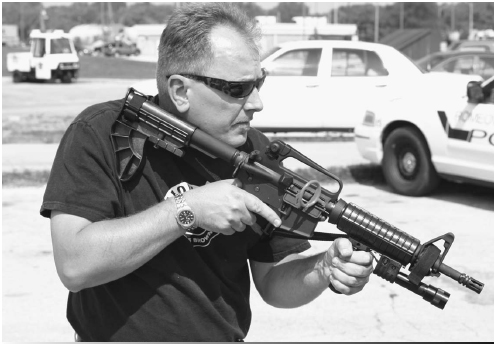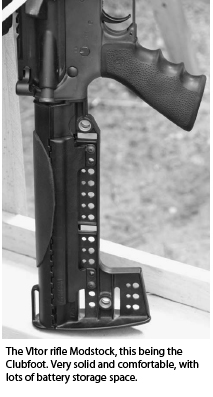
This chapter excerpt from the Gun Digest Book of the AR-15, Vol. II, covers stock options for the AR-15.
In the beginning the AR was a light, handy carbine. The M-16 had a relatively short fixed stock.
However, in a military rifle nothing can be allowed to go to waste. The hollow stock was soon redesigned with a trapdoor in the buttplate, and the enclosure was deemed large enough for a cleaning kit.
Most “old” stocks you’ll see will be “A1” stocks, with a trapdoor. In the 1980s, with the redesign of the M-16, the stock’s shortcomings were addressed. Basically, the old plastic formula was deemed too fragile. The new, A2 stock was made of tougher stuff. It was also lengthened by 5/8 of an inch. Why?
When shot prone, the old stock was a bit short for tall troops.
I find that I often have my cheek right against the carrying handle while shooting prone. If I’m not careful I’ll rap my glasses against the handle on each shot. Of course, not all troops are 6'4″ tall. And in the military you can pretty much count on those shooting for real having web gear and body armor on, adding length of pull.
But when shooting on the target range, in a shirt or jacket, the stocks were too short. So the A2 was lengthened. I even built a rifle for competition with yet-more length. Olympic Arms made (and still does) a stock filler that adds another inch to the length of pull.
With that on, I never had the carry handle hit me while shooting. However, making a rifle that is suitable for target competition is often counter-productive to combat.
What the military has found is that the A2 stock is too long for lots of soldiers and Marines in lots of the situations they face. Trying to handle a 20″ barreled, full stocked M-16A2 inside of a humvee or armored vehicle is very difficult. The Armed Forces have not decided to simply yank the A2 stocks off of every rifle. I imagine part of it is cost. It would cost a bunch of money to do so.
But it is also, and curiously, a matter of markings. If a rifle is marked “M-16A2” it is defined as having certain characteristics. If you take a rifle marked M-16A2 and you rebuild it into the M4A1 configuration, it would work just fine. It would also confuse the heck out of the supply system.
How do you note in the inventory system that a rifle marked “M-16A2” is actually a M-4A1 configuration? Every time someone does a count, they’d note it as an “A2” despite its sliding stock and stubby barrel. There isn’t room to over-strike and re-stamp the model designation. The bureaucratic mind simply boggles at the thought of exceptions.
No, if the Army is going to switch over to an all-M4 weapons issue, they’ll stuff the M-16A2s in storage and buy new M4s. But I digress.
When the stocks were changed from A1to A2 the buffer tube was not. The tube is too short for the A2 interior, so the designers included a spacer. The spacer is simply a plastic or aluminum cylinder to fill the gap.
Why couldn’t the new stocks be designed to fit without the spacer? Beats the heck out of me. For a longtime, I wondered: why not spec a new tube for the new stock, one that is longer, with a built-in buffer spring(or add-on on the buffer weight) to dampen felt recoil? I finally found out recently.
The plan was to make thenew stock longer, and make an improved short-lengthstock as well. That way, short-statured troops could have an option.
Well, as with so many good ideas, the government never got around to making improved A1-length stocks. (The government never met a good idea it couldn’t screw up.) Thus, all rifle-stock buffer tubes are the same.
It doesn’t matter if you install an A1, and A2,or some other rifl e stock, you’ll use the same buffer tube,spring and weight. You must not, however, get A1 andA2 stock screws mixed up. The A1 is the short one, A2 the long one. The A1 won’t reach if you’re trying to bolt on an A2 stock.
If you use an A2 stock screw to bolt an A1 stock on, the screw is too long: it will stick into the buffer tube. There it can easily be struck by the bufferweight while cycling, and eventually bust the buffer tube. Telestocks, however, are not all the same, nor do they ride on the same tubes.
Rifle Stocks
A1
 The original A1 stocks had no trapdoor in the buttplate. I’ve seen a few, bolted to military surplus M16A1 rifles used by police departments.
The original A1 stocks had no trapdoor in the buttplate. I’ve seen a few, bolted to military surplus M16A1 rifles used by police departments.
They are short, light, handy and a tad fragile by today’s standards. But they are entirely useable.
And for someone building a retro rifle, necessary. The later A1 style has a trapdoor incorporated in the buttplate, with a hollow cavity inside the foam plastic for storage.
It was just large enough to hold a cleaning kit. The stock was changed for the A2upgrade, and you rarely see an A1 stock on a new rifle.
A2
In the early 1980s the military (mostly the Marines)wanted an improved M-16. The Army wasn’t so hot on it, as they were (and still are, to a certain extent) pinning their future on a new rifle that would leapfrog past the M-16. (They’re still waiting.)
The A2 had a number of improvements, but the stock is our subject. The plastic formula was made stronger, the buttplate stronger, and the stock longer by 5/8″. Great for target shooting.
However, the extra length made the rifle tough to use for those bundled up in tactical gear. I’ve even seen short-statured officers in classes who were unable to use the rifle, the A2 stock was so long. How unable?
From being unable to post a passing score on drills or the qual course, to shooting perfect scores, simply from changing the rifle from the A2 to a telestock. If you are tall and long-armed, the A2 is fine.
Otherwise, it is too much of a good thing. However, it is common, and you’ll often find a standard rifle with an A2 stock on it, so you’d best be familiar with it. You can tell the A1 and A2 stocks apart by their length.
The 5/8″ difference is obvious. The buttplates are also different, the A2 being squarer on the edge than the A1. Once you’ve had a few seconds to compare them side-by-side you’ll be able to spot them afterwards. One addition I made to one of my ARs is the Olympic stock extension.
Inserted between the stock and the receiver, it adds a full inch to the length of pull. I installed it on an A1 lower I have with an A1 stock on it. The length of pull comes out to an even fourteen inches. If I put an A2 stock on, it would be more than fourteen and a half inches.
When I’m shooting prone, with iron sights, I need that much to keep the charging handle from going up my right nostril. Unless you’re tall and gangly, and plan to do prone shooting with iron sights,you probably won’t need a stock extension. But it exists if you do.

Next Step: Get your FREE Printable Target Pack
Enhance your shooting precision with our 62 MOA Targets, perfect for rifles and handguns. Crafted in collaboration with Storm Tactical for accuracy and versatility.
Subscribe to the Gun Digest email newsletter and get your downloadable target pack sent straight to your inbox. Stay updated with the latest firearms info in the industry.

![Best Concealed Carry Guns In 2025 [Field Tested] Wilson Combat EDC X9S 1](https://gundigest.com/wp-content/uploads/Wilson-Combat-EDC-X9S-1-324x160.jpg)


![Best 9mm Carbine: Affordable PCCs [Tested] Ruger Carbine Shooting](https://gundigest.com/wp-content/uploads/Ruger-Carbine-Shooting-100x70.jpg)
![Best AR-15: Top Options Available Today [Field Tested] Harrington and Richardson PSA XM177E2 feature](https://gundigest.com/wp-content/uploads/Harrington-and-Richardson-PSA-XM177E2-feature-100x70.jpg)
